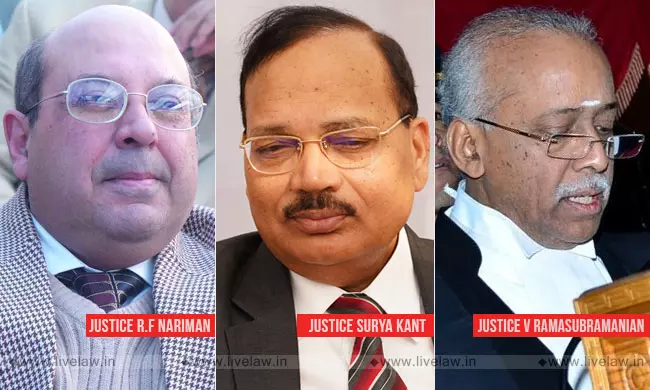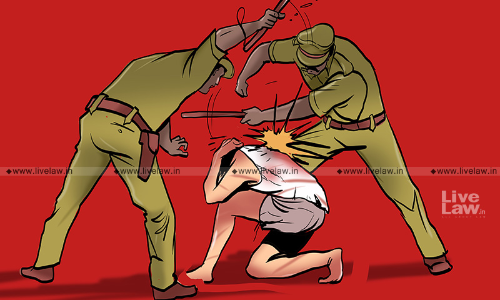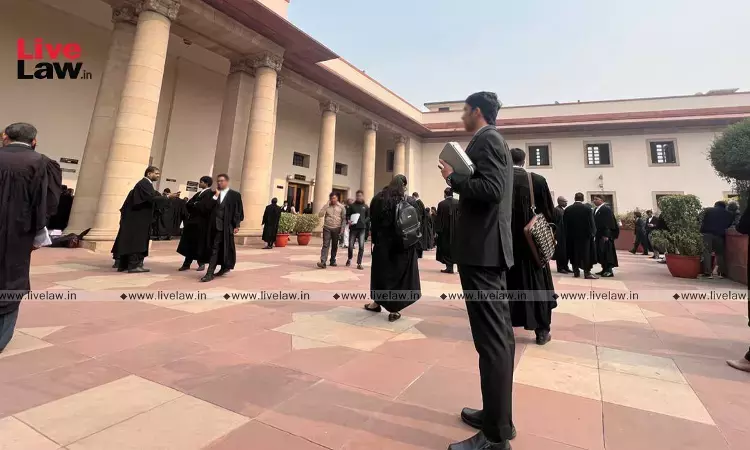Though Path-Breaking, The Operational Scope Of Sections 156(3) And 173(8) Cr.P.C. Enlarged By Breaching Judicial Propriety

I had occasion to read from www.livelaw.in, a 66-page judgment dated 16-10-2019 rendered by 3 learned Judges of the Hon'ble Supreme Court of India in Vinubhai Haribhai Malaviya and Others v. The Stateof Gujarat and Another (Criminal Appeal Nos. 478-479 of 2017). The Bench has mainly held as follows:- i. The power of the Magistrate under...
I had occasion to read from www.livelaw.in, a 66-page judgment dated 16-10-2019 rendered by 3 learned Judges of the Hon'ble Supreme Court of India in Vinubhai Haribhai Malaviya and Others v. The Stateof Gujarat and Another (Criminal Appeal Nos. 478-479 of 2017). The Bench has mainly held as follows:-
i. The power of the Magistrate under Section 156 (3) Cr.P.C. can be exercised even at the post-cognizance stage until the commencement of trial i.e. until the framing of charge. (vide para 23)
(for taking the above view the Bench refused to follow an earlier 3 Judge Bench decision in Devarapally Lakshminarayana Reddy v. Narayana Reddy (1976) 3 SCC 252 for the reason that the said decision did not notice the definition of "investigation" as contained in Section 2(h) Cr.P.C. – vide para 26)
ii. The power under Section 173 (8) Cr.P.C. can be exercised by the Magistrate at any time after the filing of the Police Report and until the commencement of trial i.e. until the charge is framed by the Magistrate. (vide para 38)
The first proposition laid down by the Bench is opposed to a catena of judicial pronouncements including Devarapally Lakshminarayana Reddy rendered by 3 learned Judges of the Supreme Court. The following are some of the rulings of the Apex Court taking the view that the power under Section 156 (3) Cr.P.C. can be exercised by the Magistrate only at the pre-cognizance stage:-
- Devarapally Lakshminarayana Reddy v. Narayana Reddy (1976) 3 SCC 252 = AIR 1976 SC 1672 – 3 Judges.
- Tula Ram v. Kishore Singh (1977) 4 SCC 459 = AIR 1977 SC 2401.
- Paras 7 to 9 of Suresh Chand Jain v. State of M.P. (2001) 2 SCC 628 = AIR 2001 SC 571.
- Para 11 of Mohd Yousuf v. Afaq Jahan (2006) 1 SCC 627 = AIR 2006 SC 705.
- Paras 17 and 18 of Dilawar Singh v. State of Delhi (2007) 12 SCC 641 = AIR 2007 SC 2234.
- Para 12 of Sakiri Vasu v. State of U.P. (2008) 2 SCC 409.
- Paras 27 and 28 of Rasiklal Dalpatram Thakkar v. State of Gujarat (2010) 1 SCC 1.
- Paras 24 to 27 of Rameshbai pandurao Hedan v. State of Gujarat (2010) 4 SCC 185.
- Para 22 of Sreenivas Gundluri v. SEPCO Electric Power Construction Corporation (2010) 8 SCC 206.
- Para 17 and 18 of Madhao v. State of Maharashtra (2013) 5 SCC 615.
- Paras 37 and 39 to 41 of Anju Chaudhary v. State of U.P. (2013) 6 SCC 384.
- Paras 14, 15 and 38 of Ramdev Food Products (P) Ltd. v. State of Gujarat (2015) 6 SCC 439 = AIR 2015 SC 1742 – 3 Judges.
The reason given by the learned Judges for distinguishing the 3 Judge Bench verdict in Devarapally Lakshminarayana Reddy is, in my opinion hardly relevant for not following the said verdict which was binding on the learned Judges, unless of course, they preferred to refer the matter to a larger Bench for an authoritative pronouncement. In fact, Devarapally Lakshminarayana Reddy was followed by another 3 Judges Bench in Ramdev Food Products (P) Ltd. shown at Serial No. 12 above.
Failure to follow the binding precedent violates judicial propriety and decorum (vide para 14 of Rajasthan Public Service Commission v. Harish Kumar Purohit (2003) 5 SCC 480 = AIR 2003 SC 3476).
The need for referring to a larger Bench becomes necessary in view of the fact that otherwise the subordinate Courts will be placed under the embarrassment of preferring one view to another, both equally binding upon them. (vide para 12 of Atma Ram v. State of Punjab AIR 1959 SC 519 – 5 Judges).
Predictability and certainty is an important hallmark of judicial jurisprudence developed in this country in the last six decades and increase in the frequency of conflicting judgments of the superior judiciary will do incalculable harm to the system inasmuch as the Courts at the grassroots will not be able to decide as to which of the judgments lay down the correct law and which one should be followed (vide para 90 of Official Liquidator v. Dayanand (2008) 10 SCC 1 – 3 Judges).
An analysis of the English and Indian law clearly leads to the irresistible conclusion that not only the judgment of a larger strength is binding on a judgment of a smaller strength, but the judgment of a co-equal strength is also binding on a Bench of Judges of co-equal strength (vide para 138 of Siddharam Satlingappa Mhetre v. State of Maharashtra (2011) 1 SCC 694).
Any attempt to distinguish a previous judgment on the ground that there was no elaborate discussion and, therefore, no reasons are discernible, is clearly violative of judicial discipline (vide J.C. Gupta v. N.K. Pandey (1988) 1 SCC 316 = AIR 1988 SC 654; Special Deputy Collector (LA) v. N. Vasudeva Rao AIR 2008 SC 944; Indra Sawhney v. Union of India 1992 Supp. (3) SCC 217 = AIR 1993 SC 477).
Consistency is the cornerstone of the administration of justice. It is consistency which creates confidence in the system and this consistency can never be achieved without respect for the rule of finality. It is with a view to achieve consistency in judicial pronouncements that Courts have evolved the rule of precedents, principle of stare decisis etc. These rules and principles are based on public policy and if they are not followed by Courts then there will be chaos in the administration of justice (vide Government of Andhra Pradesh v. A.P. Jaiswal (2001) 1 SCC 748 = AIR 2001 SC 499; Supreme Court Advocates' Association v. Union of India (1993) 4 SCC 441 = AIR 1994 SC 768; Indra Sawhney v. Union of India 1992 Supp. (3) SCC 217 = AIR 1993 SC 477).
My objection to the learned Judges who decided Vinubhai's case is not regarding their view in respect of the operational reach of Sections 156 (3) and 173 (8) Cr.P.C., but the freedom usurped by the learned Judges in taking the said view without reference to a larger Bench. However, in all fairness to the learned Judges in Vinubhai's case, there is some substance in the view they have taken that the power under Section 156 (3) Cr.P.C. can be exercised both before and after cognizance and upto the stage of commencement of trial. Courts have consistently taken the view that this power under Section 156 (3) Cr.P.C. is available to the Magistrate not only to order investigation but also to order further investigation, but adding the rider that the said power can be exercised only at the pre-cognizance stage – a view for which there is no light emanating from the Cr.P.C. I would even advocate that the said power should be available to the Magistrate/Court even after the commencement of trial, depending upon the exigencies of the case. This is because, as indicated in Vinubhai's case, there is nothing in Section 156 (3) Cr.P.C. to suggest that the said power can be exercised only at the pre-cognizance stage. What has been held by the Supreme Court right from R.R. Chari v. State of U.P. AIR 1951 SC 207 (3 Judges) onwards, is that the act of passing an order for investigation under Section 156 (3) Cr.P.C. does not amount to taking cognizance of an offence. In other words, on receiving a complaint or a Police Report, if the Magistrate orders an investigation or further investigation under Section 156 (3) Cr.P.C., the Magistrate cannot legitimately be understood to have taken cognizance of the offence. This does not necessarily mean that the power under Section 156 (3) Cr.P.C. can be exercised by the Magistrate only before he takes cognizance of the offence. The usual act of taking cognizance of an offence, as judicially settled, is by having recourse to any of the two modes-either by proceeding to record the sworn statement of the complainant and his witnesses, if any, under Chapter XV Cr.P.C. in the case of a complaint, or by proceeding to take the case on file and issue process to all or any of the accused for all or any of the offences made out against them or him, as the case may be, in the case of a Police Report.
It is pertinent to bear in mind that Section 156 (3) is the only power available to a Magistrate/Court to order investigation or further investigation in the case of a cognizable offence and the exercise of this power has to invariably end in a Police Report under Section 173 (2) Cr.P.C. It is fairly well settled by now that the power of the Magistrate to order investigation by the Police or by any other person under Section 202 (1) Cr.P.C. at the post-cognizance stage, is not for producing a Police Report under Section 173 (2) Cr.P.C., but only to enable the Magistrate to decide whether or not there is sufficient ground for proceeding further. Hence, the general power of investigation or further investigation under Section 156 (3) Cr.P.C. should be available to the Magistrate/Court right from the start to finish. But the power of further investigation under Section 173 (8) Cr.P.C. is given only to the officer-in-charge of a Police station. It is only through judicial interpretation that the Magistrate/Court has been given the power to order further investigation by triggering into motion the power of the Police under Section 173 (8) Cr.P.C. It would have been better to allow the Magistrate/Court to order investigation or further investigation under 156 (3) Cr.P.C. at any stage depending upon the exigencies of the matter and to allow the Police to exercise their power of further investigation under Section 173 (8) Cr.P.C. wherever the situation warrants.
With regard to the second proposition laid down in Vinubhai that the power under Section 173 (8) Cr.P.C. can be exercised by the Magistrate at any time after the filing of the Police Report and before the commencement of trial also, I would hasten to add that when once the power of the Magistrate/Court to order investigation or further investigation at any stage is located under Section 156 (3) Cr.P.C., there is no need to strain the language of Section 173 (8) so as to enabe the Magistrate/Court also to exercise the power of the Police to conduct further investigation under Section 173 (8) Cr.P.C. This will render Sections 156 (3) and 173 (8) Cr.P.C. meaningful without there being any necessity to travel beyond the plain language of those Sections. In the case of the power of the Police for further investigation under Section 173 (8) Cr.P.C. I am even inclined to go further to say that the said power under Section 173 (8) Cr.P.C. can be exercised by the police even after the commencement of trial in appropriate cases.
There is one statement in paragraph 26 of the judgment in Vinubhai which reads as follows:-
"The "investigation" spoken of in Section 156 (3) would embrace the entire process which begins with the collection of evidence and continues until charges are framed by the Court, at which stage the trial can be said to have begun".
With due respect, "investigation" does not extend to the stage of framing charge by the Court . Investigation ends with the filing of a complaint in a case instituted on a complaint and with the filing of the Police Report in a case instituted on a Police Report. The next stage which takes place before the Court is "inquiry" as defined under Section 2(g) Cr.P.C. "Inquiry" may go up to the stage of commencement of trial which, as per the Judge made law, starts with the framing of charge in warrant and sessions trials.
Even the proposition judicially said to have been settled by the Constitution Bench in Hardeep Singh v. State of Punjab (2014) 3 SCC 92 = AIR 2014 SC 1400 – 5 Judges that trial starts with the framing of the charge may be questionable. A reading of Section 242 (1) Cr.P.C. in warrant trial cases and of Section 230 Cr.P.C. in sessions trial cases, will show that on the charge being framed by the Court, the accused has the statutory option to "claim to be tried" in cases where he does not plead guilty. So, the trial can start only when, after the framing of charge, the accused pleads not guilty and claims to be tried. If in a case he voluntarily pleads guilty to the charge framed against him and the Court thereupon convicts him and passes a sentence according to law, can it be called a trial ? If, the mere framing of charge amounts to trial, how can we justify the Sessions Court framing a charge against the accused under Section 228 (1) (a) Cr.P.C. involving an offence not exclusively triable by a Court of Session and then transferring the case for trial to the Magistrate concerned. If with the framing of charge, the trial has started before the Sessions Court, where is the question of the Sessions Court transferring the case to the Magistrate for trial. Hence, will it not be safer to say that the question as to whether trial has started or not will depend upon the plea of the accused? Can we not say that the trial starts only when the accused pleads not guilty and claims to be tried? That will justify the Sessions Judge not taking the plea of the accused while framing charge under Section 228 (1) (a) Cr.P.C. But then, in a case where the accused is convicted and sentenced on his voluntarily pleading guilty, if it is not trial, then can he claim immunity from further trial under Section 300 (1) Cr.P.C? For attracting the bar of "double jeopardy" under Article 20 (2) of the Constitution of India, what is necessary is a prosecution and punishment which postulate a further trial. There are other grey areas even after judicial interpretation at the level of the Apex Court. For example, the Judge-made test for finding out who is a "police officer" for the purpose of Sections 25 to 27 of the Indian Evidence Act, 1872 is open to challenge and I reserve my comments in that direction to some other occasion.
Justice V. Ramkumar is Former Judge, High Court of Kerala.
Views are personal




